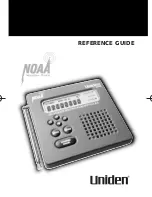
OPERATION
3-3
Revised February 1997
Part No. 001-9750-005
3.2.2 DISPLAY
Backlight -
The display has a backlight which can be
programmed to automatically turn on with transceiver
power or it can be controlled manually by the BKLHT
option switch or Menu Mode “BACKLIGHT”
parameter (see Section 3.5.5).
Figure 3-3 Front Panel Display
System Number -
Indicates the currently selected
system number. System numbers up to 99 can be
programmed.
Group Number -
Indicates the currently selected
group number. Group numbers up to 11 (Multi- Net)
or 1 (LTR/conventional) can be programmed.
Alphanumeric Display -
This 10-character area of the
display indicates the unique identification for the
selected group. For example, “GAS TRUCK” can be
displayed when a certain group is selected. It also
displays telephone numbers in the phone mode and
various error and status messages.
Status Display -
These two characters indicate the
following status information:
- Rotating clock-like symbols in both positions
indicate that system scanning is occurring. This is
also indicated during programming.
- This symbol in the left position indicates that
the displayed system is in the scan list. Likewise,
this symbol in the right position indicates that the
displayed group is in the scan list.
- This symbol in the right position indicates that
group scanning is occurring.
P1/P2 -
When a conventional system is selected,
“P1” indicates that a call is being received on a
priority 1 group, and “P2” indicates that a call is
being received on a priority 2 group. Refer to
Section 3.5.17 for more information.
ON/OF -
When the menu mode is selected by the
MENU switch, “ON” indicates that the displayed
parameter is active, and “OF” indicates that it is
inactive.
- Indicates that the function controlled by the
option switch above it is active. For example, this
symbol below the Scan switch indicates that the
scan mode is enabled. Only certain switches
require this indicator.
- Indicates that the displayed system/group is
programmed for telephone or special calls.
- Indicates that encryption is enabled.
MON -
Indicates that the monitor mode has been
enabled by taking the microphone off-hook or pressing
the MON switch (conventional systems only). The
monitor mode disables Call Guard squelch and scan-
ning so that all messages are heard on the channel.
BUSY -
Indicates when the selected system/group is
busy (conventional systems only). If this indication
appears but no message is heard and Call Guard
squelch is programmed, a call for someone else was
probably detected.
CALL -
Indicates that a call was received while the
user was away from the vehicle. It is turned off by
pressing the Select switch, an option switch, or the
microphone push-to-talk switch, or by turning power
off and then on again. Refer to Section 3.6.2 for more
information.
“
–
” -
The bars above the system and group digits indi-
cate which display will be changed if the Select switch
is turned. Refer to the Select switch description in the
preceding section for more information.
BUSY
MON
CALL
Phone
Sys/Grp
Monitor
Encryption Enabled
Alphanumeric Display
System
Number
Status
Display
Group
Number
Summary of Contents for Summit DM 975x
Page 105: ...MULTI NET SYSTEM OVERVIEW 5 10 Revised February 1997 Part No 001 9750 005 ...
Page 108: ...CIRCUIT DESCRIPTION 6 3 August 1993 Part No 001 9750 001 Figure 6 1 Transceiver Block Diagram ...
Page 123: ...CIRCUIT DESCRIPTION 6 18 August 1993 Part No 001 9750 001 ...
Page 131: ...SERVICING 7 8 Revised January 1995 Part No 001 9750 003 ...
Page 156: ...9 19 Revised December 2000 Part No 001 9750 007 TRANSCEIVER EXPLODED VIEW PART 1 ...
Page 168: ...Revised January 1995 Part No 001 9750 003 10 11 INTERCONNECT SCHEMATIC ...
Page 169: ...Revised January 1995 Part No 001 9750 003 10 12 DISPLAY BOARD SCHEMATIC ...
Page 171: ...Revised January 1995 Part No 001 9750 003 10 14 RF BOARD SCHEMATIC REVISED 800 MHZ ...
Page 172: ...Revised January 1995 Part No 001 9750 003 10 15 RF BOARD BOARD LAYOUT ALL 800 900 MHZ ...
Page 173: ...Revised January 1995 Part No 001 9750 003 10 16 RF BOARD BOARD SCHEMATIC 900 MHZ ...
Page 174: ...Revised January 1995 Part No 001 9750 003 10 17 RF BOARD BOARD SCHEMATIC UNREVISED 800 MHZ ...
Page 178: ...Revised January 1995 Part No 001 9750 003 10 21 PA BOARD SCHEMATIC 900 MHZ 30W ...
Page 179: ...Revised January 1995 Part No 001 9750 003 10 22 PA BOARD SCHEMATIC 900 MHZ 15W ...
Page 181: ...Revised January 1995 Part No 001 9750 003 10 24 PA BOARD SCHEMATIC UNREVISED 800 MHZ 35W ...
Page 182: ...Revised January 1995 Part No 001 9750 003 10 25 PA BOARD SCHEMATIC UNREVISED 800 MHZ 15W ...
Page 183: ...Revised January 1995 Part No 001 9750 003 10 26 AUDIO LOGIC BOARD SCHEMATIC PART 1 OF 2 ...
Page 184: ...Revised January 1995 Part No 001 9750 003 10 27 AUDIO LOGIC BOARD SCHEMATIC PART 2 OF 2 ...
Page 185: ...Revised January 1995 Part No 001 9750 003 10 28 AUDIO LOGIC BOARD LAYOUT TOP VIEW ...
Page 186: ...Revised January 1995 Part No 001 9750 003 10 29 AUDIO LOGIC BOARD LAYOUT BOTTOM VIEW ...
Page 188: ...Revised January 1995 Part No 001 9750 003 10 31 REMOTE TRANSCEIVER INTERCONNECT SCHEMATIC ...
Page 189: ...Revised January 1995 Part No 001 9750 003 10 32 REMOTE CONTROL UNIT INTERFACE BOARD SCHEMATIC ...
Page 216: ...Part Number 001 9750 007 12 00 hph Printed in U S A ...
















































